Soil Microbial Community and Their Relationship with Soil Properties across Various Landscapes in the Mu Us Desert
Abstract
:1. Introduction
2. Materials and Methods
2.1. Sample Collection
2.2. Soil Physicochemical Properties, Enzyme Activity, and Biomass Determination
2.3. High-Throughput Sequencing and Bioinformatics Analysis
2.4. Microbial Community Structure Analysis
3. Results
3.1. Soil Physicochemical Properties, Enzyme Activity, and Biomass Determination
3.2. Bacterial Community Structure Characteristics
3.3. Fungal Community Structure Characteristics
4. Discussion
5. Conclusions
Author Contributions
Funding
Data Availability Statement
Conflicts of Interest
References
- Bassett, T.J.; Zuéli, K.B. Environmental discourses and the Ivorian savanna. Ann. Am. Assoc. Geogr. 2000, 90, 67–95. [Google Scholar] [CrossRef]
- Wen, X.R.; Cheng, Y.P.; Zhang, J.K.; Dong, H. Ecological function zoning and protection of groundwater in Asia. J. Groundw. Sci. Eng. 2021, 9, 359–368. [Google Scholar]
- Oraon, P.R.; Sagar, V.; Beauty, K. Ecological restoration of degraded land through afforestation activities. Land. Environ. Manag. For. 2023, 1, 201–216. [Google Scholar] [CrossRef]
- Bulletin on Desertification and Desertification Status in China: State Forestry and Grassland Administration. 2015. Available online: http://www.forestry.gov.cn/uploadfile/main/2011-1/file/2011-1-5-59315b03587b4d7793d5d9c3aae7ca86.pdf (accessed on 13 November 2022).
- Liu, Q.; Zhang, Q.; Yan, Y.; Zhang, X.; Niu, J.; Svenning, J.C. Ecological restoration is the dominant driver of the recent reversal of desertification in the Mu Us Desert (China). J. Clean. Prod. 2020, 268, 122241. [Google Scholar] [CrossRef]
- Wei, Y.; Zhen, L.; Du, B. The evolution of desertification control and restoration technology in typical ecologically vulnerable regions. J. Resour. Ecol. 2022, 13, 775–785. [Google Scholar]
- Raj, A.; Jhariya, M.K.; Banerjee, A.; Nema, S.; Bargali, K. Land degradation and restoration: Implication and management perspective. Land. Environ. Manag. For. 2023, 1, 1–21. [Google Scholar] [CrossRef]
- Gao, S.; Wu, J.; Ma, L.; Gong, X.; Zhang, Q. Introduction to sand-restoration technology and model in China. Sustainability 2022, 15, 98. [Google Scholar] [CrossRef]
- Hagemann, M.; Henneberg, M.; Felde, V.J.; Drahorad, S.L.; Berkowicz, S.M.; Felix-Henningsen, P.; Kaplan, A. Cyanobacterial diversity in biological soil crusts along a precipitation gradient, Northwest Negev Desert, Israel. Microb. Ecol. 2015, 70, 219–230. [Google Scholar] [CrossRef] [PubMed]
- Zhao, Y.Y.; Gao, G.L.; Qin, S.G.; Yu, M.H.; Ding, G.D. Desertification detection and the evaluation indicators: A review. J. Arid. Land. Resour. Environ. 2019, 33, 81–87. [Google Scholar]
- Yu, Z.L. Ecology: Current Knowledge and Future Challenges; High Education Press: Beijing, China, 2016. [Google Scholar]
- Sokol, N.W.; Slessarev, E.; Marschmann, G.L.; Nicolas, A.; Blazewicz, S.J.; Brodie, E.L.; Pett-Ridge, J. Life and death in the soil microbiome: How ecological processes influence biogeochemistry. Nat. Rev. Microbiol. 2022, 20, 415–430. [Google Scholar] [CrossRef]
- Zheng, Q.; Hu, Y.; Zhang, S.; Noll, L.; Böckle, T.; Dietrich, M.; Wanek, W. Soil multifunctionality is affected by the soil environment and by microbial community composition and diversity. Soil. Biol. Biochem. 2019, 136, 107521. [Google Scholar] [CrossRef] [PubMed]
- Delgado-Baquerizo, M.; Oliverio, A.M.; Brewer, T.E.; Benavent-González, A.; Eldridge, D.J.; Bardgett, R.D.; Fierer, N. A global atlas of the dominant bacteria found in soil. Science 2018, 359, 320–325. [Google Scholar] [CrossRef] [PubMed]
- Green, J.L.; Holmes, A.J.; Westoby, M.; Oliver, I.; Briscoe, D.; Dangerfield, M.; Beattie, A.J. Spatial scaling of microbial eukaryote diversity. Nature 2004, 432, 747–750. [Google Scholar] [CrossRef] [PubMed]
- Li, W.; Zhang, F.; Cui, G.; Wang, Y.; Yang, J.; Cheng, H.; Zhang, L. Effects of bio-organic fertilizer on soil fertility, microbial community composition, and potato growth. Sci. Asia 2021, 47, 347. [Google Scholar] [CrossRef]
- Lupwayi, N.Z.; Ellert, B.H.; Bremer, E.; Smith, E.G.; Petri, R.M.; Neilson, J.A.; Janzen, H.H. Ramifications of crop residue loading for soil microbial community composition, activity and nutrient supply. Soil. Use Manag. 2023, 39, 402–414. [Google Scholar] [CrossRef]
- Weldmichael, T.G.; Szegi, T.; Denish, L.; Gangwar, R.K.; Michéli, E.; Simon, B. The patterns of soil microbial respiration and earthworm communities as influenced by soil and land-use type in selected soils of Hungary. Soil. Sci. Annu. 2020, 71, 43–52. [Google Scholar] [CrossRef]
- Song, H.K.; Shi, Y.; Yang, T.; Chu, H.; He, J.S.; Kim, H.; Adams, J.M. Environmental filtering of bacterial functional diversity along an aridity gradient. Sci. Rep. 2019, 9, 866. [Google Scholar] [CrossRef] [PubMed]
- Wang, B.Z.; Zhang, C.X.; Liu, J.L.; Zeng, X.W.; Li, F.R.; Wu, Y.C.; Jia, Z.J. Microbial community changes along a land-use gradient of desert soil origin. Pedosphere 2012, 22, 593–603. [Google Scholar] [CrossRef]
- Wu, B.; Ci, L.J. Landscape change and desertification development in the Mu Us Sandland, Northern China. J. Arid. Environ. 2002, 50, 429–444. [Google Scholar] [CrossRef]
- Yan, J.; Lou, L.; Bai, W.; Zhang, S.; Zhang, N. Phosphorus deficiency is the main limiting factor for re-vegetation and soil microorganisms in Mu Us Sandy Land, Northwest China. Sci. Total. Environ. 2023, 900, 165770. [Google Scholar] [CrossRef]
- Shi, S.; Zhao, F.; Ren, X.; Meng, Z.; Dang, X.; Wu, X. Soil infiltration properties are affected by typical plant communities in a semi-arid desert grassland in China. Water 2022, 14, 3301. [Google Scholar] [CrossRef]
- Gerenfes, D.; Giorgis, A.; Negasa, G. Comparison of organic matter determination methods in soil by loss on ignition and potassium dichromate method. Int. J. Hortic. Food Sci. 2022, 4, 49–53. [Google Scholar] [CrossRef]
- Hicks, T.D.; Kuns, C.M.; Raman, C.; Bates, Z.T.; Nagarajan, S. Simplified Method for the Determination of Total Kjeldahl Nitrogen in Wastewater. Environments 2022, 9, 55. [Google Scholar] [CrossRef]
- Yan, S.; Liu, C.; Li, J.; Li, J.; Cui, C.; Fan, J.; Yan, C. Changes in the soil phosphorus supply with rice straw return in cold region. Agronomy 2023, 13, 2214. [Google Scholar] [CrossRef]
- Fei, Y.; Huang, S.; Zhang, H.; Tong, Y.; Wen, D.; Xia, X.; Wang, H.; Luo, Y.; Barceló, D. Response of soil enzyme activities and bacterial communities to the accumulation of microplastics in an acid cropped soil. Sci. Total. Environ. 2020, 707, 135634. [Google Scholar] [CrossRef] [PubMed]
- Nirala, N.R.; Asiku, J.; Dvir, H.; Shtenberg, G. N-acetyl-β-d-glucosaminidase activity assay for monitoring insulin-dependent diabetes using Ag-porous Si SERS platform. Talanta 2022, 239, 123087. [Google Scholar] [CrossRef] [PubMed]
- Mori, T.; Wang, S.; Wang, C.; Mo, J.; Zhang, W. Is microbial biomass measurement by the chloroform fumigation extraction method biased by experimental addition of N and P? iForest 2021, 14, 408. [Google Scholar] [CrossRef]
- Ren, X.; Hao, S.; Yang, C.; Yuan, L.; Zhou, X.; Zhao, H.; Yao, J. Alterations of intestinal microbiota in liver cirrhosis with muscle wasting. Nutrition 2021, 83, 111081. [Google Scholar] [CrossRef]
- Huang, Z.; Cui, Z.; Liu, Y.; Wu, G.L. Carbon accumulation by Pinus sylvestris forest plantations after different periods of afforestation in a semiarid sandy ecosystem. Land. Degrad. Dev. 2021, 32, 2094–2104. [Google Scholar] [CrossRef]
- Cao, H.; Gao, G.; Zhang, Y.; Guo, M.; Ren, Y.; Ding, G. Soil bacterial approach to assessing afforestation in the desertfied Northern China. J. Clean. Prod. 2021, 292, 125935. [Google Scholar] [CrossRef]
- Güner, Ş.T.; Erkan, N.; Karataş, R. Effects of afforestation with different species on carbon pools and soil and forest floor properties. Catena 2021, 196, 104871. [Google Scholar] [CrossRef]
- Chen, W.; Yu, T.; Zhao, C.; Li, B.; Qin, Y.; Li, H.; Zhang, X. Development and determinants of topsoil bacterial and fungal communities of afforestation by aerial sowing in Tengger Desert, China. J. Fungi 2023, 9, 399. [Google Scholar] [CrossRef] [PubMed]
- Yao, Y.; Shao, M.; Fu, X.; Wang, X.; Wei, X. Effect of grassland afforestation on soil N mineralization and its response to soil texture and slope position. Agric. Ecosyst. Environ. 2019, 276, 64–72. [Google Scholar] [CrossRef]
- Mongil-Manso, J.; Navarro-Hevia, J.; San Martín, R. Impact of land use change and afforestation on soil properties in a Mediterranean mountain area of central Spain. Land 2022, 11, 1043. [Google Scholar] [CrossRef]
- Sharma, P.; Sharma, M.M.M.; Malik, A.; Vashisth, M.; Singh, D.; Kumar, R.; Pandey, V. Rhizosphere, rhizosphere biology, and rhizospheric engineering. In Plant Growth-Promoting Microbes for Sustainable Biotic and Abiotic Stress Management; Springer International Publishing: Cham, Switzerland, 2021; pp. 577–624. [Google Scholar]
- Vokou, D.; Chalkos, D.; Karamanlidou, G.; Yiangou, M. Activation of soil respiration and shift of the microbial population balance in soil as a response to Lavandula stoechas essential oil. J. Chem. Ecol. 2002, 28, 755–768. [Google Scholar] [CrossRef] [PubMed]
- Yang, X.; Deng, S.; De Philippis, R.; Chen, L.; Hu, C.; Zhang, W. Chemical composition of volatile oil from Artemisia ordosica and its allelopathic effects on desert soil microalgae, Palmellococcus miniatus. Plant. Physiol. Biochem. 2012, 51, 153–158. [Google Scholar] [CrossRef] [PubMed]
- Cotrufo, M.F.; Wallenstein, M.D.; Boot, C.M.; Denef, K.; Paul, E. The M icrobial Efficiency-M atrix S tabilization (MEMS) framework integrates plant litter decomposition with soil organic matter stabilization: Do labile plant inputs form stable soil organic matter? Glob. Chang. Biol. 2013, 19, 988–995. [Google Scholar] [CrossRef] [PubMed]
- Shen, J.P.; Zhang, L.M.; Guo, J.F.; Ray, J.L.; He, J.Z. Impact of long-term fertilization practices on the abundance and composition of soil bacterial communities in Northeast China. Appl. Soil. Ecol. 2010, 46, 119–124. [Google Scholar] [CrossRef]
- Santonja, M.; Rancon, A.; Fromin, N.; Baldy, V.; Hättenschwiler, S.; Fernandez, C.; Mirleau, P. Plant litter diversity increases microbial abundance, fungal diversity, and carbon and nitrogen cycling in a Mediterranean shrubland. Soil. Biol. Biochem. 2017, 111, 124–134. [Google Scholar] [CrossRef]
- Eilers, K.G.; Lauber, C.L.; Knight, R.; Fierer, N. Shifts in bacterial community structure associated with inputs of low molecular weight carbon compounds to soil. Soil. Biol. Biochem. 2010, 42, 896–903. [Google Scholar] [CrossRef]
- Liu, J.; Sui, Y.; Yu, Z.; Shi, Y.; Chu, H.; Jin, J.; Wang, G. Soil carbon content drives the biogeographical distribution of fungal communities in the black soil zone of northeast China. Soil. Biol. Biochem. 2015, 83, 29–39. [Google Scholar] [CrossRef]
- Fierer, N.; Bradford, M.A.; Jackson, R.B. Toward an ecological classification of soil bacteria. Ecology 2007, 88, 1354–1364. [Google Scholar] [CrossRef] [PubMed]
- Girvan, M.S.; Bullimore, J.; Pretty, J.N.; Osborn, A.M.; Ball, A.S. Soil type is the primary determinant of the composition of the total and active bacterial communities in arable soils. Appl. Environ. Microb. 2003, 69, 1800–1809. [Google Scholar] [CrossRef] [PubMed]
- Wang, H.; Guo, S.; Huang, M.; Thorsten, L.H.; Wei, J. Ascomycota has a faster evolutionary rate and higher species diversity than Basidiomycota. Sci. China Life Sci. 2010, 53, 1163–1169. [Google Scholar] [CrossRef] [PubMed]
- Taylor, J.W.; Berbee, M.L. Dating divergences in the Fungal Tree of Life: Review and new analyses. Mycologia 2006, 98, 838–849. [Google Scholar] [CrossRef] [PubMed]
- Hibbett, D.S.; Blackwell, M.; James, T.Y.; Spatafora, J.W.; Taylor, J.W.; Vilgalys, R. Phylogenetic taxon definitions for fungi, dikarya, ascomycota and basidiomycota. IMA Fungus 2018, 9, 291–298. [Google Scholar] [CrossRef] [PubMed]
- Clemmensen, K.E.; Finlay, R.D.; Dahlberg, A.; Stenlid, J.; Wardle, D.A.; Lindahl, B.D. Carbon sequestration is related to mycorrhizal fungal community shifts during long-term succession in boreal forests. New Phytol. 2015, 205, 1525–1536. [Google Scholar] [CrossRef]
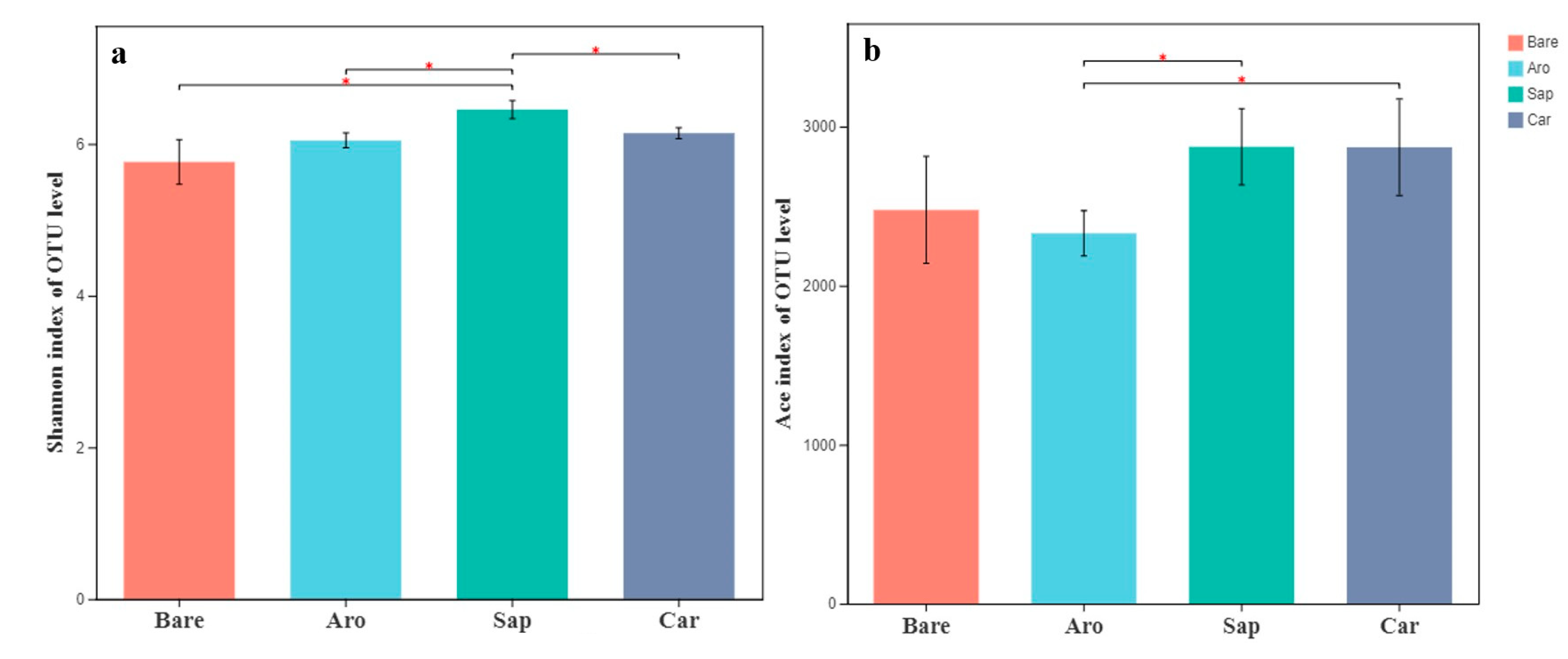
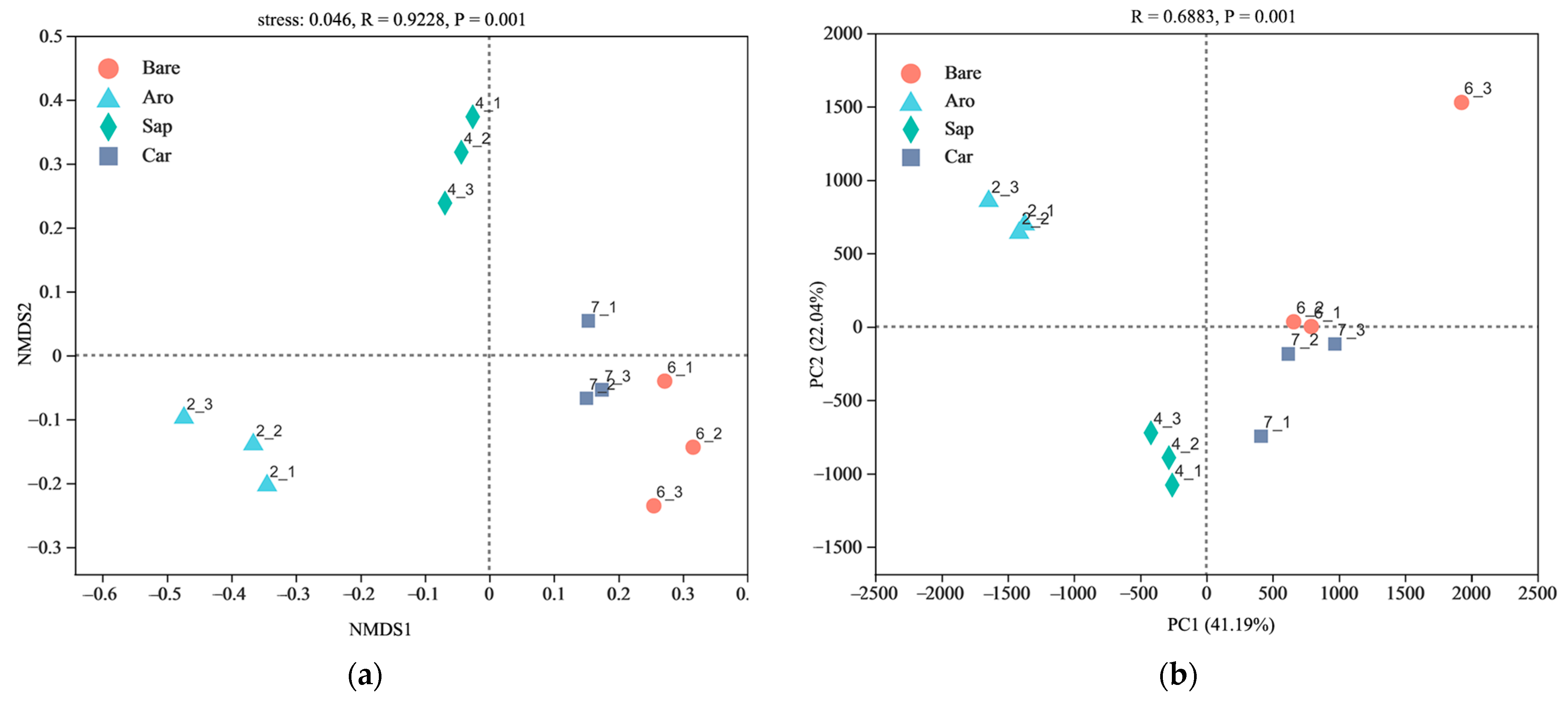

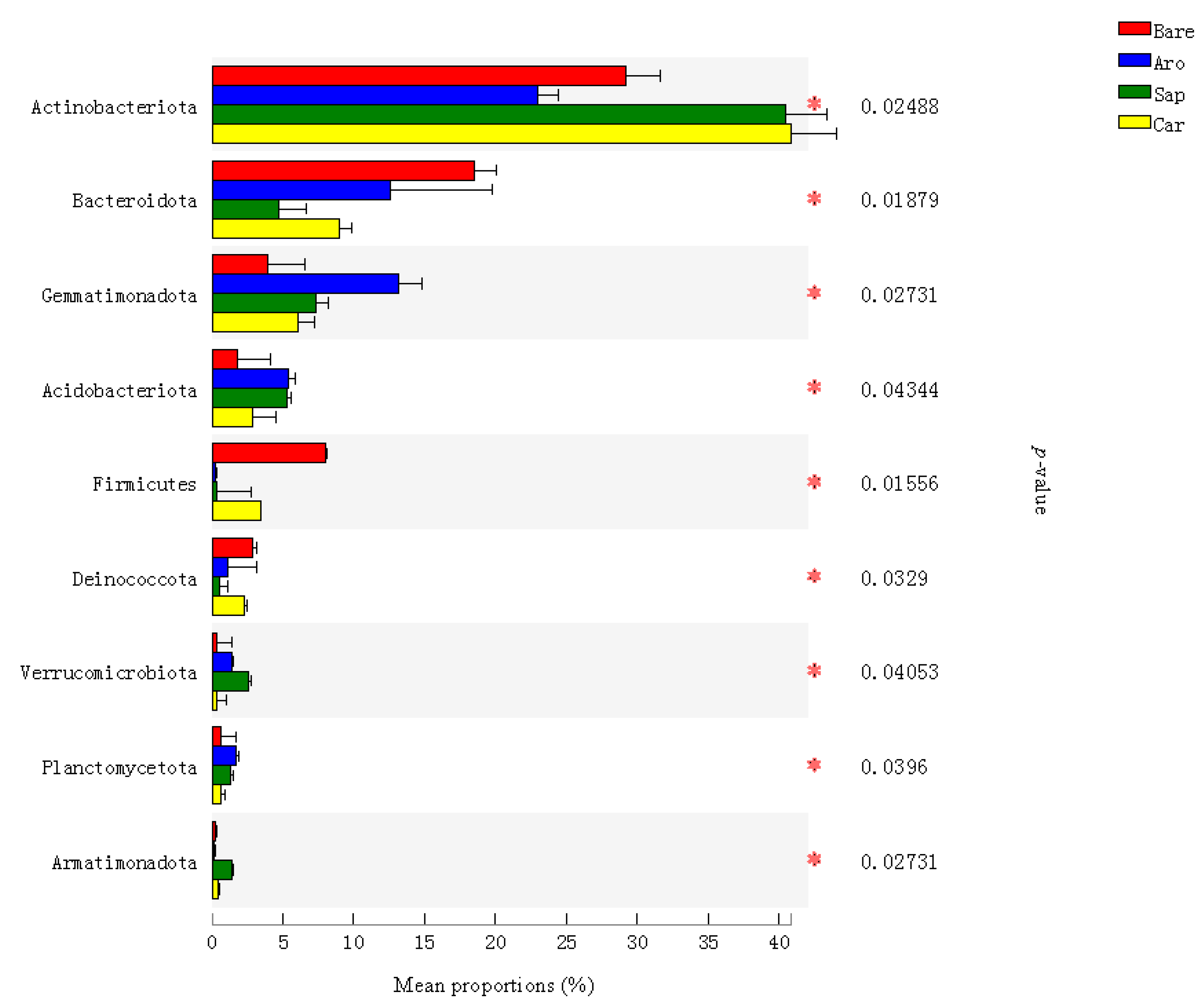
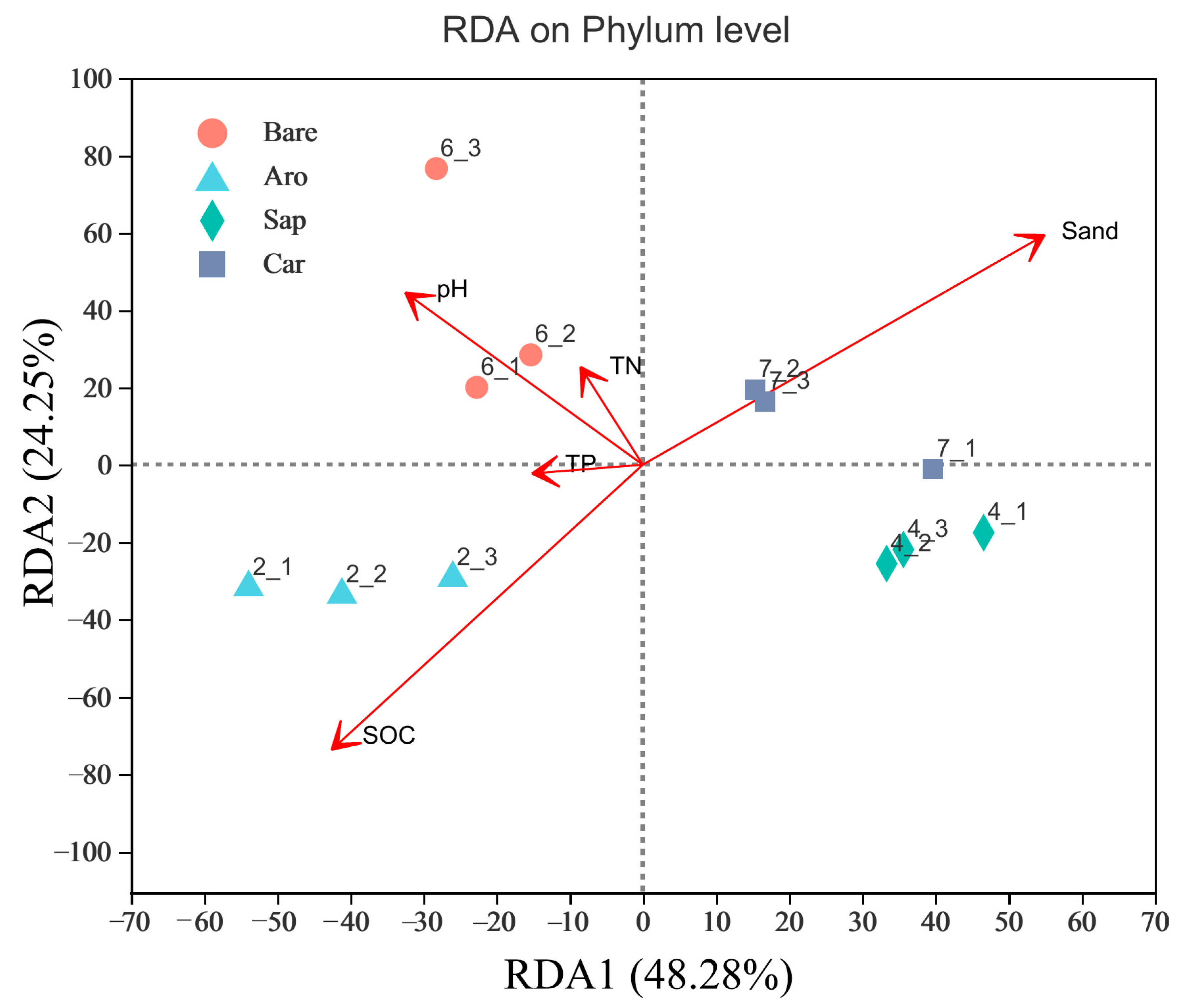
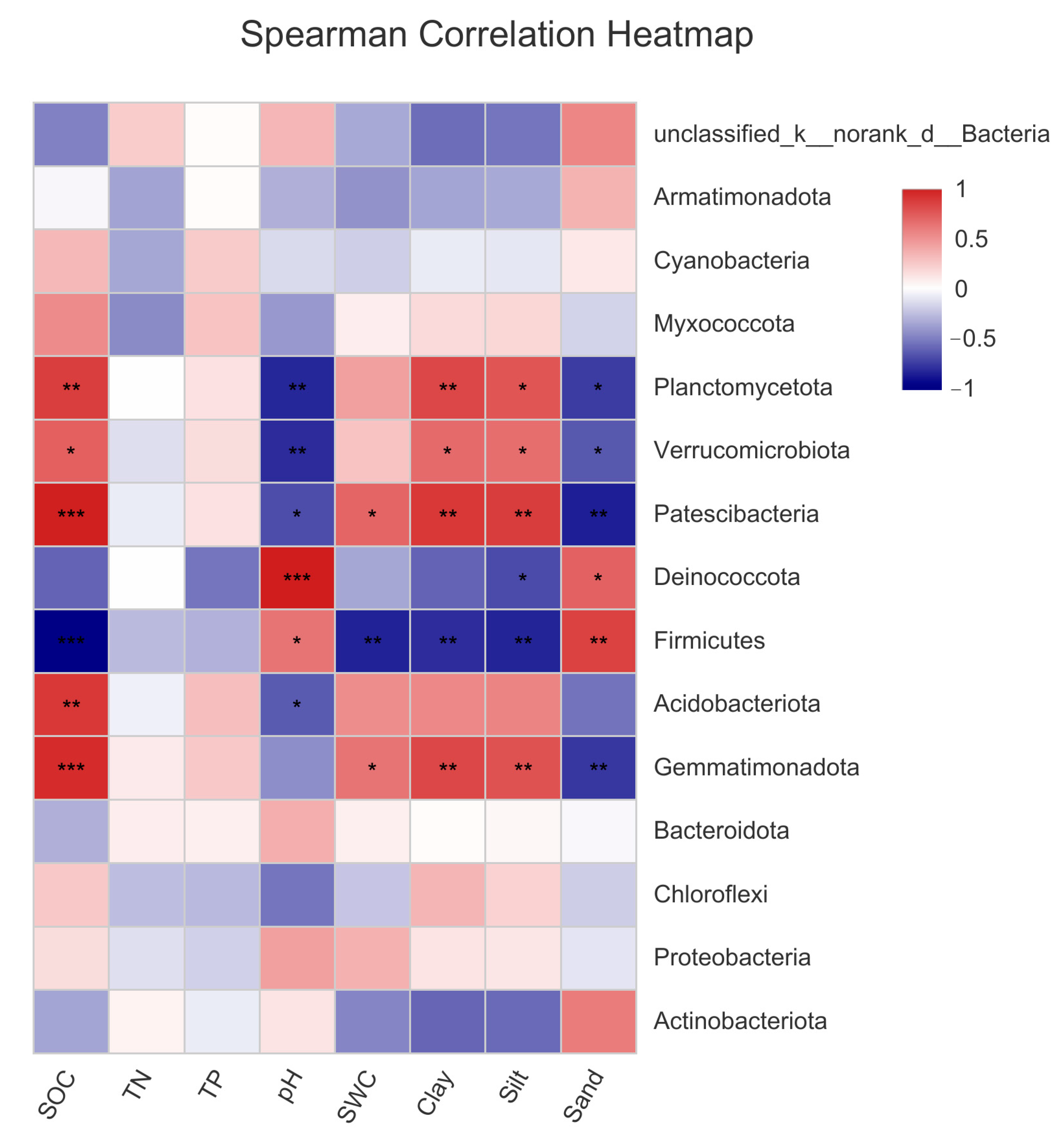
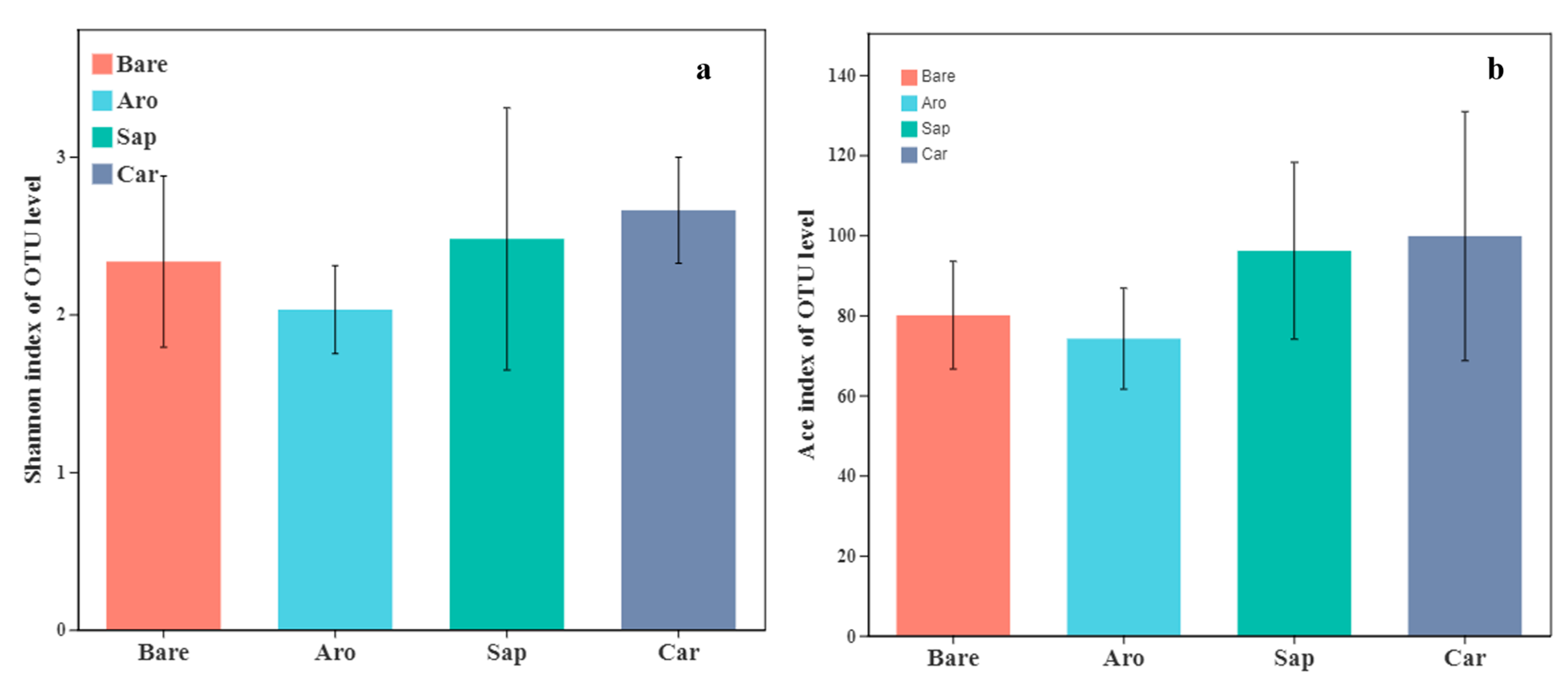
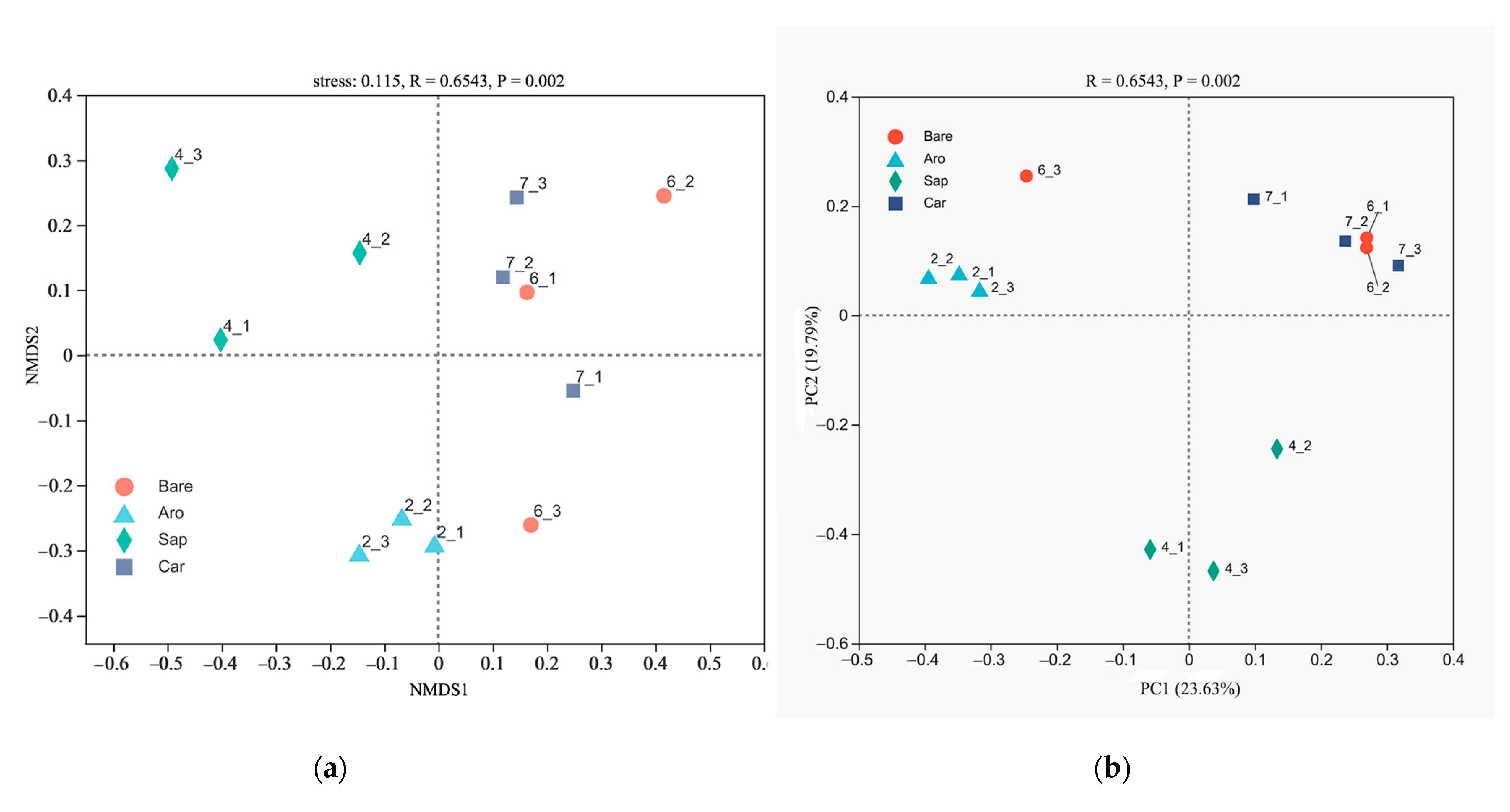
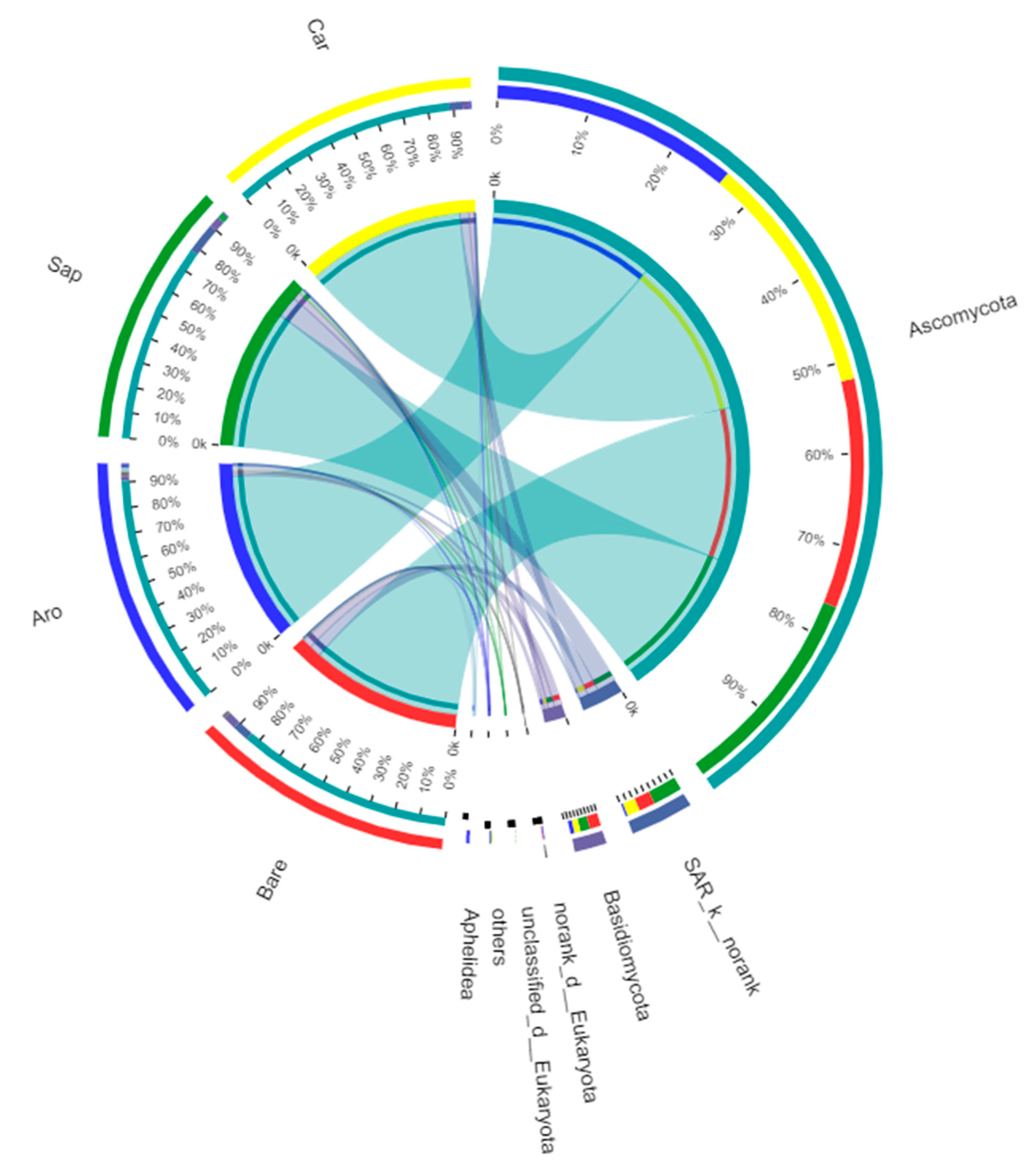
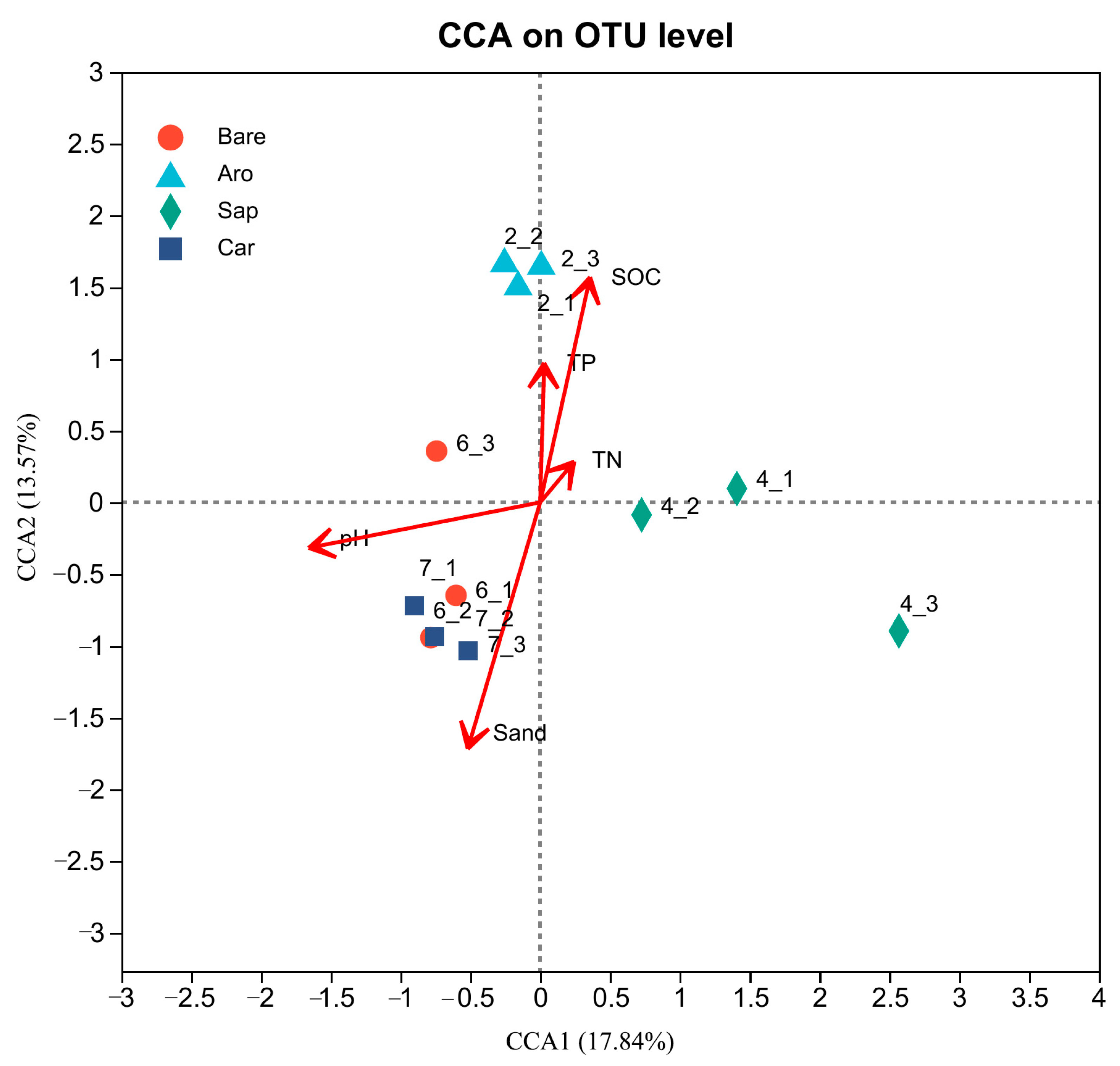
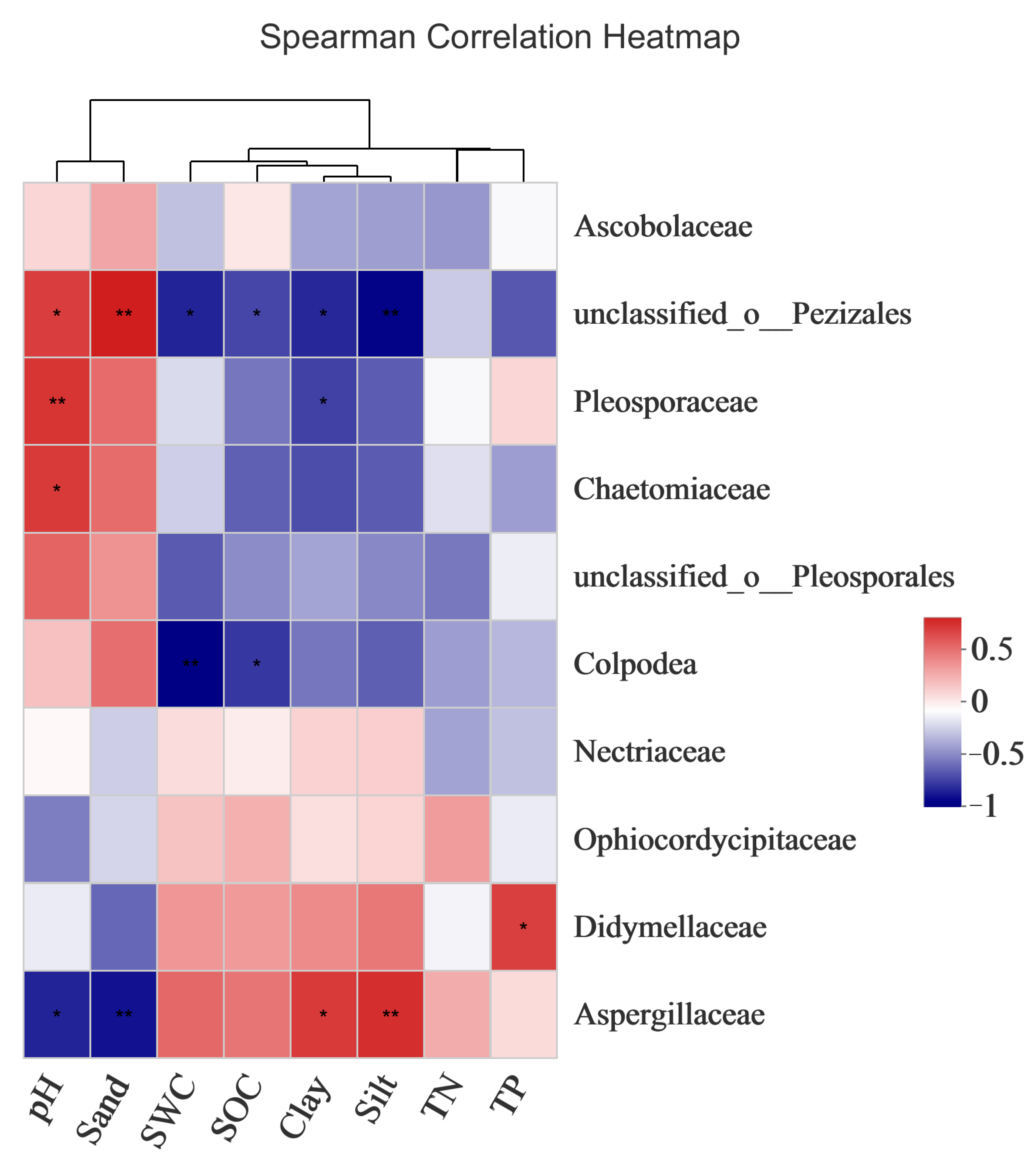
| Soil Properties | Experimental Sites | |||
|---|---|---|---|---|
| Bare Sandy Land | Artemisia ordosica | Salix psammophila | Caragana korshinskii | |
| SWC | 1.53 ± 0.32 a | 2.62 ± 0.23 b | 1.72 ± 0.31 a | 1.68 ± 0.22 a |
| pH | 8.38 ± 0.22 a | 8.85 ± 0.22 a | 8.94 ± 0.36 a | 8.81 ± 0.23 a |
| SOC (g/kg) | 0.84 ± 0.03 a | 3.46 ± 0.35 b | 2.57 ± 0.06 c | 1.55 ± 0.14 d |
| TN (g/kg) | 0.07 ± 0.01 a | 0.35 ± 0.02 b | 0.48 ± 0.02 c | 0.51 ± 0.02 c |
| TP (g/kg) | 0.18 ± 0.03 a | 0.51 ± 0.02 b | 0.69 ± 0.02 b | 0.46 ± 0.02 b |
| Plant diversity | 0 | 0.98 ± 0.01 a | 0.63 ± 0.07 b | 0.70 ± 0.03 b |
| Microbial carbon (mg/kg) | 26.9 ± 0.23 a | 150 ± 12 b | 110 ± 6.56 c | 60 ± 3.56 d |
| Microbial nitrogen (mg/kg) | 1.23 ± 0.11 a | 11.0 ± 0.17 b | 9.1 ± 0.56 b | 3.3 ± 0.23 c |
| Acid phosphatase | 0.25 ± 0.12 a | 0.75 ± 0.01 b | 0.52 ± 0.06 c | 0.38 ± 0.03 d |
| N-acetyl-beta-D-glucosaminidase | 0.57 ± 0.11 a | 1.41 ± 0.02 b | 1.12 ± 0.23 c | 0.98 ± 0.08 d |
Disclaimer/Publisher’s Note: The statements, opinions and data contained in all publications are solely those of the individual author(s) and contributor(s) and not of MDPI and/or the editor(s). MDPI and/or the editor(s) disclaim responsibility for any injury to people or property resulting from any ideas, methods, instructions or products referred to in the content. |
© 2023 by the authors. Licensee MDPI, Basel, Switzerland. This article is an open access article distributed under the terms and conditions of the Creative Commons Attribution (CC BY) license (https://creativecommons.org/licenses/by/4.0/).
Share and Cite
Wang, L.; Li, X. Soil Microbial Community and Their Relationship with Soil Properties across Various Landscapes in the Mu Us Desert. Forests 2023, 14, 2152. https://doi.org/10.3390/f14112152
Wang L, Li X. Soil Microbial Community and Their Relationship with Soil Properties across Various Landscapes in the Mu Us Desert. Forests. 2023; 14(11):2152. https://doi.org/10.3390/f14112152
Chicago/Turabian StyleWang, Lihua, and Xuewu Li. 2023. "Soil Microbial Community and Their Relationship with Soil Properties across Various Landscapes in the Mu Us Desert" Forests 14, no. 11: 2152. https://doi.org/10.3390/f14112152
APA StyleWang, L., & Li, X. (2023). Soil Microbial Community and Their Relationship with Soil Properties across Various Landscapes in the Mu Us Desert. Forests, 14(11), 2152. https://doi.org/10.3390/f14112152





